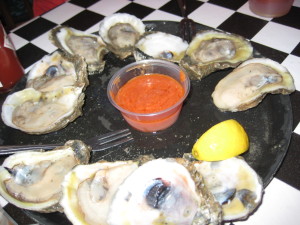The opportunistic pathogen Vibrio vulnificus occurs naturally in estuarine habitats and is readily cultured from water and oysters under warm conditions but infrequently at ambient conditions of <15°C.
 The presence of V. vulnificus in other habitats, such as sediments and aquatic vegetation, has been explored much less frequently. This study investigated the ecology of V. vulnificus in water by culture and quantitative PCR (qPCR) and in sediment, oysters, and aquatic vegetation by culture.
The presence of V. vulnificus in other habitats, such as sediments and aquatic vegetation, has been explored much less frequently. This study investigated the ecology of V. vulnificus in water by culture and quantitative PCR (qPCR) and in sediment, oysters, and aquatic vegetation by culture.
V. vulnificus samples were taken from five sites around Tampa Bay, FL. Levels determined by qPCR and culture were significantly correlated (P = 0.0006; r = 0.352); however, V. vulnificus was detected significantly more frequently by qPCR (85% of all samples) compared to culture (43%). Culturable V. vulnificus bacteria were recovered most frequently from oyster samples (70%), followed by vegetation and sediment (∼50%) and water (43%). Water temperature, which ranged from 18.5 to 33.4°C, was positively correlated with V. vulnificus concentrations in all matrices but sediments. Salinity, which ranged from 1 to 35 ppt, was negatively correlated with V. vulnificus levels in water and sediments but not in other matrices. Significant interaction effects between matrix and temperature support the hypothesis that temperature affects V. vulnificus concentrations differently in different matrices and that sediment habitats may serve as seasonal reservoirs for V. vulnificus.
V. vulnificus levels in vegetation have not been previously measured and reveal an additional habitat for this autochthonous estuarine bacterium.
Sediment and vegetation as reservoirs of Vibrio vulnificus in the Tampa Bay estuary and Gulf of Mexico
Applied and Environmental Microbiology
Eva Chase, Suzanne Young, and Valerie J. Harwood
http://aem.asm.org/content/81/7/2489.abstract?etoc
The foodborne pathogen Vibrio parahaemolyticus has been reported as being present in New Zealand (NZ) seawaters, but there have been no reported outbreaks of foodborne infection from commercially grown NZ seafood. Our study determined the current incidence of V. parahaemolyticus in NZ oysters and Greenshell mussels and the prevalence of V. parahaemolyticus tdh and trh strains.
Pacific (235) and dredge (21) oyster samples and mussel samples (55) were obtained from commercial shellfish-growing areas between December 2009 and June 2012. Total V. parahaemolyticus numbers and the presence of pathogenic genes tdh and trh were determined using the FDA most-probable-number (MPN) method and confirmed using PCR analysis.
 In samples from the North Island of NZ, V. parahaemolyticus was detected in 81% of Pacific oysters and 34% of mussel samples, while the numbers of V. parahaemolyticus tdh and trh strains were low, with just 3/215 Pacific oyster samples carrying the tdh gene. V. parahaemolyticus organisms carrying tdh and trh were not detected in South Island samples, and V. parahaemolyticus was detected in just 1/21 dredge oyster and 2/16 mussel samples. Numbers of V. parahaemolyticus organisms increased when seawater temperatures were high, the season when most commercial shellfish-growing areas are not harvested. The numbers of V. parahaemolyticus organisms in samples exceeded 1,000 MPN/g only when the seawater temperatures exceeded 19°C, so this environmental parameter could be used as a trigger warning of potential hazard.
In samples from the North Island of NZ, V. parahaemolyticus was detected in 81% of Pacific oysters and 34% of mussel samples, while the numbers of V. parahaemolyticus tdh and trh strains were low, with just 3/215 Pacific oyster samples carrying the tdh gene. V. parahaemolyticus organisms carrying tdh and trh were not detected in South Island samples, and V. parahaemolyticus was detected in just 1/21 dredge oyster and 2/16 mussel samples. Numbers of V. parahaemolyticus organisms increased when seawater temperatures were high, the season when most commercial shellfish-growing areas are not harvested. The numbers of V. parahaemolyticus organisms in samples exceeded 1,000 MPN/g only when the seawater temperatures exceeded 19°C, so this environmental parameter could be used as a trigger warning of potential hazard.
There is some evidence that the total V. parahaemolyticus numbers increased compared with those reported from a previous 1981 to 1984 study, but the analytical methods differed significantly.
Long-term study of Vibrio parahaemolyticus prevalence and distribution in New Zealand shellfish
Applied and Environmental Microbiology
D. Cruz, D. Hedderley, and G. C. Fletcher
